Scottish Health Survey 2019: summary report
Key finding from the Scottish Health Survey 2019 report.
This document is part of a collection
Chapter 6 Diet and Obesity
In 2019, around one in five of all adults consumed five or more portions of fruit and vegetables a day *, similar to levels recorded since 2003.
- 21% in 2003
- 22% in 2019
Contrary to the previous trend of women being more likely than men to consume the recommended five-a-day portions of fruit and vegetables, there was no significant difference between men and women in 2019.
Consumption of 5 or more fruit and veg portions a day in 2019
- 23% Women
- 21% Men
Mean portions of fruit and vegetables per day
- women 3.3 portions per day (mean)
- men 3.2 portions per day (mean)
In 2019, around one in seven children aged 2 –15 met the five-a-day recommendation for consumption of fruit and vegetables.
- 14%
Girls were significantly more likely to meet the recommendation than boys.
- 16% Girls
- 12% Boys
In 2019, children aged 2– 4 years were more likely to consume five or more portions of fruit and vegetables on a typical day than older children.
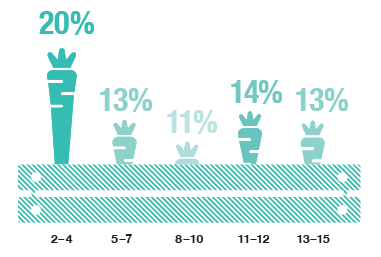
Girls have consumed higher levels of fruit and vegetables per day* than boys in most years since 2008.
Mean portions of fruit and vegetables per day
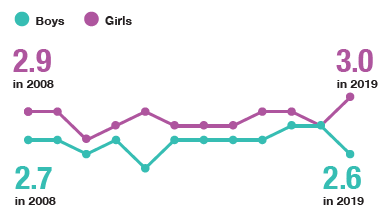
In 2019, two in three adults were overweight including obesity **, the highest prevalence in the time series since 2003. Obesity *** prevalence has remained relatively stable since 2008.
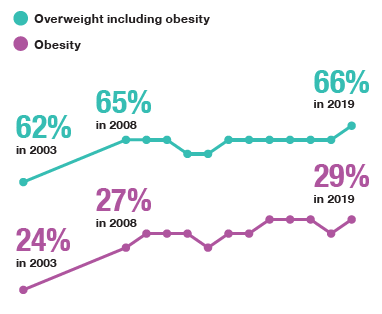
In 2019, women were more likely than men to be within the healthy weight range †.
- 29% Women
- 36% Men
The mean BMI of women was significantly higher than men in the youngest age group in 2019.
- 25.9 kg/m2 women aged 16-24
- 23.9 kg/m2 men aged 16-24
In 2019, mean BMI increased with age.
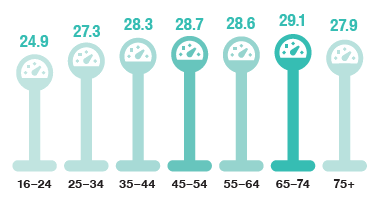
** BMI of 25 kg/mÇ or over.
*** BMI of 30 kg/m2 or over.
† BMI of 18.5 to less than 25 kg/m2.
The proportion of children (aged 2–15) in the healthy weight range † † has remained fairly stable since 1998.
- 70% in 1998
- 72% in 2015
- 68% in 2019
The highest proportion of children in the healthy weight range was among those aged 7–11, and the lowest among those aged 12–15.
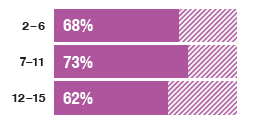
Just under a fifth of children were at risk of obesity in 2019 with similar levels observed for boys and girls.
- 16% of children at risk of obesity
Women were more likely than men to be categorised as 'high health risk or above' based on their BMI and waist circumference † † † .
- 55% women
- 44% men
This difference was clearest among the youngest adults.
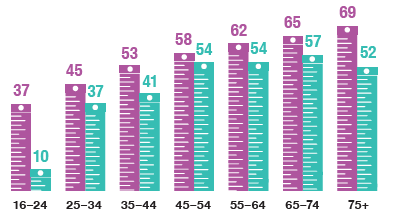
† † BMI above the 2nd percentile or below the 85th percentile.
† † † According to SIGN guidelines.
Food insecurity levels (as defined by being worried during the past 12 months that they would run out of food due to lack of money or resources) remained at 9% in 2019.
- 8% in 2017
- 9% in 2018
- 9% in 2019
Food insecurity was more prevalent among younger than older adults in 2019.
- 13% 16-44
- 8% 45-64
- 2% 65+
Adults living in single parent households were most likely to report being food insecure.
- 31% Single parent household (one adult any age and one or more children † † † † )
- 20% Single adult household (one adult aged 16–64, no children)
- 13% Large family household (two adults of any age and three or more children; or three or more adults and one or more children)
- 9% Small family household (two adults of any age and one or two children)
- 8% Small adult household (two adults under 65, no children)
- 6% Large adult household (three or more adults, no children)
- 2% Single older adult household (one adult aged 65 or over)
- 2% Older smaller family household (comprising two adults only, at least one of whom is aged 65 or over)
† † † † Largely single mothers
Contact
There is a problem
Thanks for your feedback